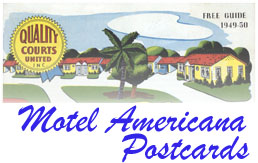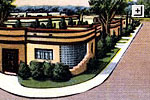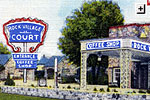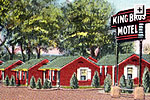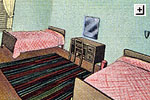Whenever your Route 66 journey takes you through St. Louis, it's always a good idea to stop at Ted Drewes Frozen Custard. During our Monday evening visit, the size and enthusiasm of the crowd reminds me of a Hollywood movie premier. Some locals come in shorts and t-shirts, while some of the women wait in dresses and heels. Inside the building, about twenty yellow shirted teenagers hustle under the crush of business as cars stream in and out of the parking lot. Ted Drewes has been here since 1929 and used to be about a third of its current size. For years, the owners petitioned the city for permission to enlarge the building so that the hundreds of locals and their out-of-state friends who show up every night wouldn't have to wait so long in line for a taste of Concrete - that famous vanilla flavored custard named for its amazingly thick texture.
In this part of town, the title of Route 66 has given way to Watson Road. Yet, despite the 1995 demolition of the famous Coral Court Motel, many of the old era buildings remain. We visit the Chippewa Motel with its glowing blue arrow and stop by the Duplex Motel for a spell. But we linger at the Wayside Motel ("phone in every room"). The sign features pink, green, and orange bubbles that blink in rapid succession. I step past twin stone pillars to explore the buildings, a set of interconnected cottages separated by garages. Walking down the curving road, I realize how quiet it is here. There are very few lighted occupancies, just dim a office sign that casts a glow over the huge satellite dish. Inside, a framed illustration of the motel in its prime depicts crisply cut lawns and white painted curbs. Back outside, in a small fenced courtyard, three women gaze out over the streetscene below, speaking in hushed tones.
Just before Watson mutates into Interstate 44, we stop at the Westward Motel. Even though the AAA logo has long been removed, children scamper happily around the lit pool. In the office, Tom the night manager chats with Suzie who's been staying here for the last couple months, waiting to buy a house. Both share their memories of the place and the demise of the Coral Court. "I've even got some of their sheets and pillow cases," Suzie says, "but I've never been there. This is God's honest truth." Tom shows me a postcard of the old building and describes the changes that road realignment have brought to the Westward. Some things haven't changed that much though; the motel continues to attract return visitors: "I've had people come in who are married now for their anniversary or something and they come in because this is the first place they ever did it. They come in and want the same exact room." He points up to a collection of wagon wheels, horse shoes, and other western gear above the desk, "just that knitted thing looks a little older." Suzie then takes me into a room that holds an all-in-one oven, sink, stove, and ice box: "now that's what you call old," she replies.
![[Gardenway]](gardenway.jpeg) We stay at the Gardenway Motel, named for the Henry Shaw Garden way road. In his 1946 Guidebook to Highway 66, Jack Rittenhouse noted that the Garden Way was "a section planted along the highway to display native trees, shrubs and plants." Today, you can still find an 1100 acre arboretum behind the motel. In our room, we find blankets with leaf patterns (with matching curtains) and walls that look like they've been painted about a dozen times, but the beautiful neon sign glows through our window as if for the first time. The next morning, a little girl calls me over next to a pushcart full of cleaning supplies. She's wearing a birthday hat and proudly displays her twirling ballerina doll. Apparently, there are few kids to play with around here, and she's glad for some company.
We stay at the Gardenway Motel, named for the Henry Shaw Garden way road. In his 1946 Guidebook to Highway 66, Jack Rittenhouse noted that the Garden Way was "a section planted along the highway to display native trees, shrubs and plants." Today, you can still find an 1100 acre arboretum behind the motel. In our room, we find blankets with leaf patterns (with matching curtains) and walls that look like they've been painted about a dozen times, but the beautiful neon sign glows through our window as if for the first time. The next morning, a little girl calls me over next to a pushcart full of cleaning supplies. She's wearing a birthday hat and proudly displays her twirling ballerina doll. Apparently, there are few kids to play with around here, and she's glad for some company.
We head southwest on Route 66 toward our destination for the day, Oklahoma City. Before too long, Jenny spots the Sunset Motel. In the trees, the sound of insects greet us as we make the slow turn around the U-shaped building. White gravel is our only driveway. In front of the Sunset, a rusted refrigerator with an old ammunition box on top shimmers in the morning heat. Two-by-fours support a makeshift roof. Later in our travels, I find an old postcard of this place. In the pale yellow walls and manicured lawn, I find a subtle form of elegance that has been long discarded.
![[Ozark]](ozark.jpeg) Back on the road, near the Meramec Caverns, we spy the remnants of Ozark Court. The sign stands atop a rusty iron pole next to a brick wall. Weeds climb one of the doors in a form of organic ornamentation. The office is filled with lumber suggesting that this motel is being renovated. One story tells how the Ozark was once owned by a retired cop who created a speed-trap town here with himself as Justice of the Peace. That financial savvy has not been lost to today's route 66 survivors. Business of all types cling to the most tenuous links to this old stretch of highway. Along with the expected motels and truck stops, we find convenience stores, car dealerships, and even a consignment shop that has named itself after the mother road.
Back on the road, near the Meramec Caverns, we spy the remnants of Ozark Court. The sign stands atop a rusty iron pole next to a brick wall. Weeds climb one of the doors in a form of organic ornamentation. The office is filled with lumber suggesting that this motel is being renovated. One story tells how the Ozark was once owned by a retired cop who created a speed-trap town here with himself as Justice of the Peace. That financial savvy has not been lost to today's route 66 survivors. Business of all types cling to the most tenuous links to this old stretch of highway. Along with the expected motels and truck stops, we find convenience stores, car dealerships, and even a consignment shop that has named itself after the mother road.
In Cuba, we stop at the Wagon Wheel Motel. Green chairs line many of the ozark stone cottages under the shadow of local water tower. Tiny, but immaculate rooms entice us to stay. In front of the office guarded by concrete poodles, fake elves compete with ducks bedecked in colorful bonnets for our attention. Nearby, a young maple tree grows where an elm used to stand, giving shade to a stone squirrel. The owners celebrate the renewed appreciation for the highway that passes their motel, showing me the gifts that some of their international visitors have given them. Roy recalls: "a young lady got out of the car. [I asked] 'Can I help you? What do you want?' She couldn't talk. So I went over to the car and she got a camera. She came back and I say, 'ahhh... take all the pictures you want.' Then there was that one guy - he had a camera. It was this high!"
![[Munger Moss Motel]](munger.jpeg) The Munger Moss Motel in Lebanon is a 50 year veteran of route 66. It started as a BBQ joint up in Devil's Elbow before it was bypassed by the four lane. The owners moved it to its current location and built the motel which has survived the interstate encroachment to this day. Ramona, an owner of this place, is generous with her recollections of local history. She points out the pictures of celebrities who performed for troops at nearby Fort Leonard Wood, but stayed at the Munger Moss. "A lot of people do not like anything old," she says, "I had a man here this spring - and he really hurt my feelings - just said, 'you're old.' Well yeah, I know it's old . . . but they're still more who appreciate it. When route 66 first came back, this guy was from California comes in and says, 'I shot a whole roll of photos in your bathroom!' And I said, ' you did what?' He says, 'The color tile is so beautiful.' I said, 'well, I'll be darned." Across the street at the Forest Manor ("We sell sleep"), lanterns hang from wooden posts. Along each door is a hand-painted wooden sign with flowers, stove pots, and notes that say, "bless this house."
The Munger Moss Motel in Lebanon is a 50 year veteran of route 66. It started as a BBQ joint up in Devil's Elbow before it was bypassed by the four lane. The owners moved it to its current location and built the motel which has survived the interstate encroachment to this day. Ramona, an owner of this place, is generous with her recollections of local history. She points out the pictures of celebrities who performed for troops at nearby Fort Leonard Wood, but stayed at the Munger Moss. "A lot of people do not like anything old," she says, "I had a man here this spring - and he really hurt my feelings - just said, 'you're old.' Well yeah, I know it's old . . . but they're still more who appreciate it. When route 66 first came back, this guy was from California comes in and says, 'I shot a whole roll of photos in your bathroom!' And I said, ' you did what?' He says, 'The color tile is so beautiful.' I said, 'well, I'll be darned." Across the street at the Forest Manor ("We sell sleep"), lanterns hang from wooden posts. Along each door is a hand-painted wooden sign with flowers, stove pots, and notes that say, "bless this house."
In Carthage - a town once known as the crossroads of America - we finish our tour of Missouri at the Boots Motel. Built as a tourist court in 1939 by Arthur Boots, this site used to advertise a radio in every room. It is also said that Clark Gable once stayed in Room 6. In front of the office, you can give your pedal foot a break in one of the pink or green pastel chairs. The manager needs little prompting to add his opinion about the place: "yep, it was a popular place at one time - back in the 30s, 40s, 50s, and 60s. You had both roads coming in at the corner. You had 71 coming in from the north and 66 coming in from the east and everybody darn near travelling cross country had to go by it. The freeway's done away with that." Before I leave, he gives me a postcard of "the other route 66" - a stretch of road that links east and west St. Croix.
Trying to reach Oklahoma City by midnight, we race through the tiny portion of Kansas that holds onto the old highway, leaving Missouri behind.
![[camera]](camera.gif) Wayside Motel
Wayside Motel